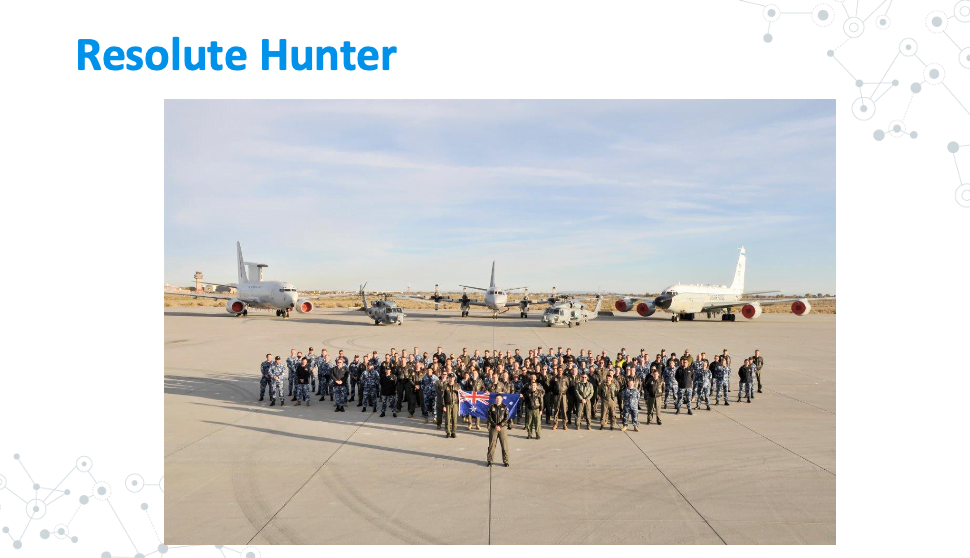By Robbin Laird
One can conceive of multi-domain strike over an extended operational area by building on a virtual revolution in the relationships among ISR, counter-ISR and C2. The dynamics of change involving ISR, Counter-ISR and C2 is obviously a major subject on its own but it is a central one to understand how a distributed force will generate multi-domain strike in areas of tactical and strategic interest.
The intersection of these subjects has been one which the Williams Foundation has addressed in some of the presentations in past seminars.
For example, then AIRCDRE Phillips who is now Air Marshal Phillips, Chief of Guided Weapons and Explosive Ordnance, noted in a 2019 Williams Foundation Seminar: “Earlier we built a dedicated single network connection for a specific task, such as providing targeting information to the platforms involved in a specific operation…With the new technologies and capabilities, we are now reusing networks for multiple purposes and making sure that they can adapt to the changing con-ops as well.”
“We are seeing integration of the networks and the integration of the information management services and then the dual nature of the applications on top of those integrations. Rather than building a single purpose intel common operating picture, we are now capable of building an integrated intelligence and battlespace management common operating picture for the use of the combat forces engaged in operations.”
In other words, “we are building an adaptable network of networks. In traditional networks, when data is brought in from a dedicated system, it needs to be repurposed for other tasks as needed.”
Put in other terms, the “networked” force was built around platforms that would use networked information to create desired and often scripted events. But the C2 and ISR revolution we are now facing is reversing the logic of platforms to infrastructure; it is now about how flexible C2 and ISR interactive systems can inform the force elements to shape interactive combat operations on the fly.
That is, the new capabilities are enabling tactical decision making at the edge and posing real challenges to traditional understandings of how information interacts with decision making.
It is about learning how to fight effectively at the speed of light in order to achieve combat dominance. And these new capabilities are providing a real impact on force development, concepts of operations and force training as well.
At the 27 September 2023 seminar, the enablement of the force to cross-operate, to do third-party targeting (which is a hallmark of fifth generation aircraft by the way) and to be able to use ISR to deceive the enemy as well as to guide operation actions to deliver meaningful strike for the desired “proportional effect” was the assumption underlying the notion of expanding the way ahead for multi-domain strike. Or put in other words, the dynamics of change involving ISR, Counter-ISR and C2 are part of the multi-domain strike enterprise.
With the sensor revolution, not only are sensors much smaller but they proliferate through the operational force. If one operates a dedicated ISR platform, the range of tasks which that platform can do now compare to the past is truly amazing. The case of the Triton is a case in point of what it can see, what it can sense, what it can communicate and what it can target. And sensors can operate from a variety of platforms as integral elements of dedicated modular payloads, as we are seeing on the new maritime autonomous systems.
But it it not only seeing the battlespace writ large, it is the ability of the tactical combat force or cluster to have at its service incredible ISR assets given the dynamics of change associated with sensor sets. And associated with this is the ability of decentralized C2 to operate a force with mission command which by being distributed enhances its survivability but can reach out to other platforms and work with such platforms to deliver the multi-domain strike which the seminar has focused upon.
But not discussed at the seminar is the other aspect of the ISR revolution, what might be called counter ISR. In an interview I did earlier this year with a senior commander in the Pacific, he underscored the importance of counter-ISR in providing operational deception giving the force greater ability not only to survive but to find the choke points where multi-domain strike could have its most decisive impact.
The mix of C2, ISR and counter-ISR was described by this senior commander as follows: “The higher headquarters may have access to better information and when it does it needs to have the ability to reach out to the tactical level to tell them to do or not do something associated with the larger political and strategic picture.”
He felt that they were making significant progress in commanding a distributed force, which is a core element of shaping a force capable of deterrence in the Pacific. “We are capable of commanding from various locations and can be able to see and understand how to command in the battlespace dozens of ships, hundreds of aircraft, thousands of personnel. We are capable of seeing, understanding, and deciding what is going on in the battlespace, and tracking the enemy force using exquisite means way beyond a grease pencil and a radio call. We can and do so through links and sensor from the sea floor to the heavens.”
Holding all this together is not only assured command and control but the tissue of ISR systems enabling distributed fleet operations and adding the key element of deception through various counter-ISR systems as well. In effect, fleet distribution built on a kill web effects infrastructure is being combined with what me be called a wake-a-mole operational capability. You can’t target me, if you can’t find me.
The force is being distributed for survivability, but the joint force has focused considerably attention on a core capability which many cubical commandos have ignored – namely the ability of the force to become very difficult to target when on distributed operations.
In my discussion with this commander, he indicated that one of highest priorities for ongoing development and funding is what he calls “counter-ISR” capabilities. As he put it: “That is why counter-ISR is the number one priority for me, to deny the adversary with to high confidence in his targeting capabilities. I need to deceive them and to make a needle look like a needle in a haystack of needles. It is important to have the capability to look like a black hole in the middle of nothing.”
This particular interview put together the relationships among C2, ISR and counter ISR for a distributed maritime force quite succinctly. And at the seminar, a number of the presentations provided insights with regard to the dynamics of change in the ISR and C2 areas.
Jake Campbell, Northrop Grumman Australia, at the last seminar discussed the importance of having layered ISR to allow for both the strategic and technical operational visibility necessary to make rapid, timely and effective decision making, notably for a distributed force but which would allow for strategic C2 as well.
In his presentation to the 27 September seminar, he highlighted the challenges of providing the kind of ISR which is needed in a contested environment for net-enabled weapons.
Actually, Jake was the only speaker who use this term but the multi-domain strike being discussed was built around net-enabled weapons or put in other terms third party targeting where a weapon launched for land, sea, or air could then be targeted from somewhere else. And that clearly is only going to work if you have accurate targeting information that comes from your ISR capabilities and a correct decision made by the shooter.
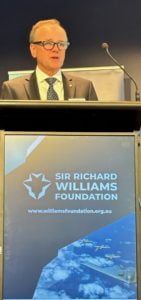
He argued: “Within the ADF we really need to get our minds around the problem of doing such targeting in a degraded environment.”
He noted: “The ability to generate a 24/7 target quality information, perhaps over some weeks, so that operational commanders have flexibility to generate a strike at the time and place of choosing is going to be challenging, but it’s the demand. And as you’re getting closer to those strikes, you have to have the ability to maintain what I call a chain of custody.”
“You’re going to need to have eyes on that target with high fidelity target quality information and have the ability to communicate that to the weapons when they are fired.”
Triton is a key capability which Northrop Grumman is working with the RAAF for the ADF ISR and T capabilities. Campbell noted Triton has can provide data outside of the adversaries weapons engagement zone but also provide a range of data which will allow the ADF to make more effective targeting decisions with the reach and range of Triton’s onboard sensors.
This reminded me of a comment made to me when visiting Jax Navy a few years ago. I asked a Triton operate: “What happens when your system is targeted?” His answer was direct: “Well I can see weapons at a distance few can match. I have a jet engine so I move and maneuver.”
Campbell noted that the U.S. Navy and its use of the the Minotaur fusion engine is of significance in how the U.S .Navy is integrating ISR information across the force.He raised this in the context of discussing the involvement of the Triton surrogate in a Northern Edge exercise.
“We operated the Triton surrogate, which is it’s a test platform that we put all the Triton sensors on, in the Northern Edge exercise, in a maritime strike scenario, where the goal was to generate a 24/7 maritime Common Operating Picture to be able to provide target quality information for the commander and then generate strike options against representative threats but to do so outside of the adversary’s weapons engagement zones of significance.
“In contrast to other platforms, Triton sensors are actually able to operate and function well outside of the adversary’s weapon engagement zones right now and we are working on an ongoing basis to evolve this capability. And the height and perspective of Triton is an important factor in being able to so.
“But the other thing that came out of the exercise was the importance of data fusion. There’s a system that was used in this exercise called Minotaur. Minotaur is a data fusion system that allows multiple aircraft and ships to share the network information.
“It is a data fusion engine by which users can access information from whatever terminal they are on as long as you’re on the Minotaur Web. Triton and P-8s have Minotaur on them as part of their capability. And the U.S. Navy is headed full steam down the Minotaur pathway. It’s important for the ADF to get their head around what Minotaur brings to the fight and how we plug into it.”
In an interview I did a few years ago, I discussed Minotaur with the then head of the US Navy’s Maritime Patrol Reconnaissance Enterprise. According to Rear Admiral Garvin who was the head of the enterprise at the time: “The Maritime Patrol and Reconnaissance aviator of the future will be well versed in the synergy inherent in both manned and unmanned platforms.”
“The unblinking stare of a Triton enhances the Fleet Commander’s MDA and understanding of an adversary’s pattern-of-life by observing their movements in the optical and electromagnetic spectrum.”
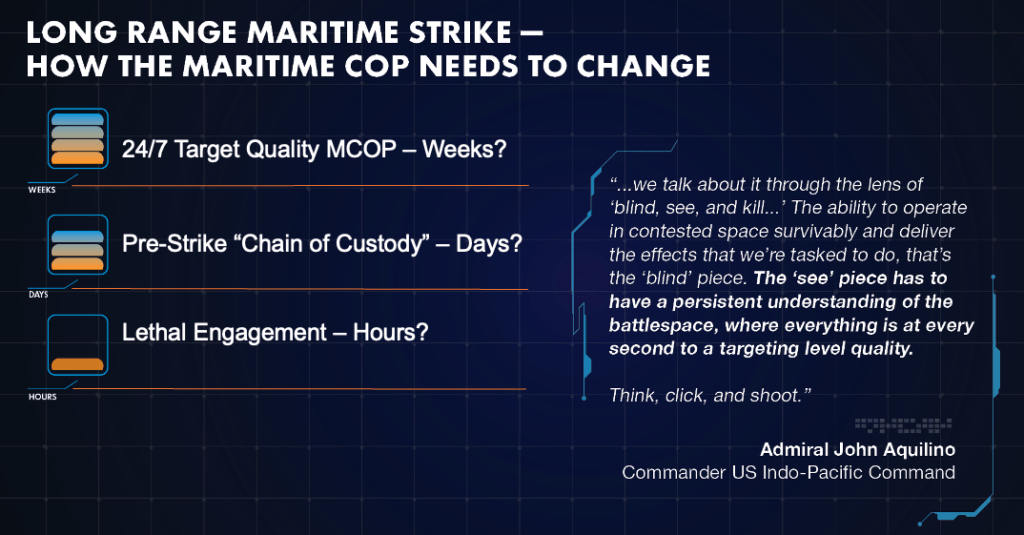
“Moreover, Triton serves as a force multiplier and enabler for the P-8. Early in Triton program development, we embraced manned and unmanned teaming and saw it as a way to expand our reach and effectiveness in the maritime domain.”
“One key software capability which empowers integration is Minotaur.”
“The Minotaur Track Management and Mission Management system was developed in conjunction with the Johns Hopkins University Applied Physics Laboratory. Minotaur was designed to integrate sensors and data into a comprehensive picture which allows multiple aircraft and vessels to share networked information.”
“It is basically a data fusion engine and like many software capabilities these days, doesn’t physically have to be present on a platform to be of use.”
“These capabilities ride on a Minotaur web where, if you are on the right network, you can access data from whatever terminal you happen to be on.”
(See chapter six “an ISR-empowered force” in my co-authored book entitled: A Maritime Kill Web Force in the Making: Deterrence and Warfighting in the XXIst Century.)
The Navy experience working with ISR was also significant to the perspectives of WGCDR Marija Jovanovich. In particular, she talked about her work with Pete “Two Times” Salvaggio, Naval Aviation Warfighting Development Center (NAWDC), Maritime ISR (MISR) Weapons School, Department Head (DH), MISR & EP-3E Weapons and Tactics Instructor (WTI) at Resolute Hunter.
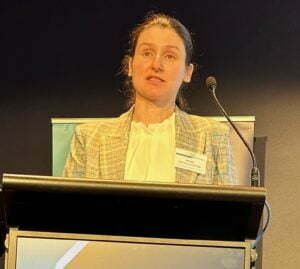
The WGCDR made it very clear that the work of “Two Times” and of the Navy led Resolute Hunter expressed her core emphasis on the expanded role for ISR in shaping any multi-domain strike enterprise. And in this context, she is one of the few people discussing the subject which highlighted the new innovative role in the Navy of what they call MISR officers.
In an interview I did with “Two Times” in 2020 (and later that year I went to Resolute Hunter), he explained what they were all about and what the WGCDR was advocating.
“Kill chain is to find, fix, track, target, engage and assess. For the US Navy, the weight of effort has been upon target and engage. As “Two Times” puts it “But if you cannot find, fix or track something, you never get to target.”
“There is another challenge as well: in a crisis, knowing what to hit and what to avoid is crucial to crisis management. This clearly requires the kind of ISR management skills to inform the appropriate decision makers as well.
“The ISR piece is particularly challenging as one operates across a multi-domain battlespace to be able to identify the best ISR information, even it is not contained within the ISR assets within your organic task force. And the training side of this is very challenging.
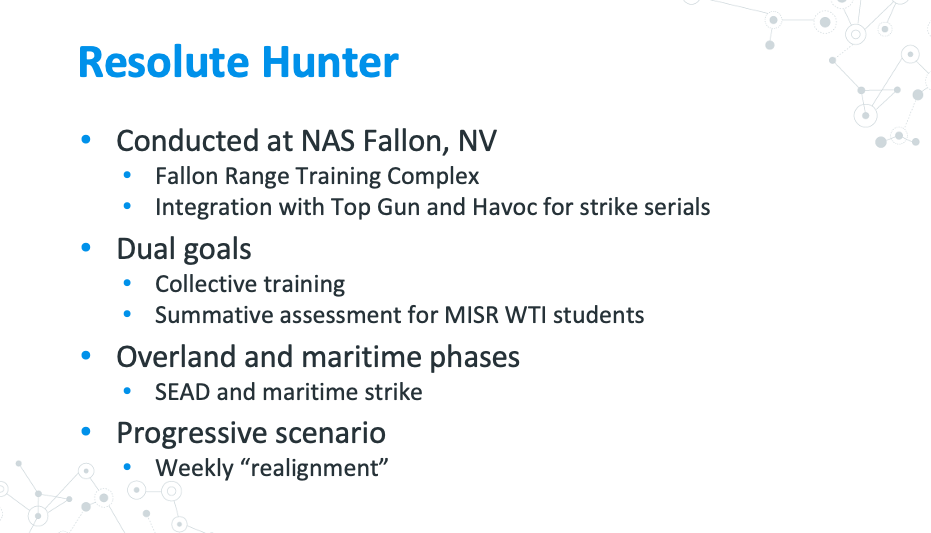
“That challenge might be put this way: How does one build the skills in the Navy to do what you want to do with regard to managed ISR data and deliver it in the correct but timely manner and how to get the command level to understand the absolute centrality of having such skill sets?
“Two Times” identified a number of key parameters of change with the coming of MISR.
“We are finally breaking the old mindset; it is only now that the department heads at NAWDC are embracing the new role for ISR in the fight.”
“We are a unique organization at NAWDC for we do not own a platform. And the MISR school has both officers and enlisted in the team. We are not all aviators; we have intel specialists, we have cryptographers, pilots, crewmen etc.
“Aviators follow a more rapid pace of actions; non-aviators do not have the same pace of working rapidly within chaos. Our goal at MISR is to be comfortable to work in chaos.”
“Another part of the shift is to get recognition that ISR does not SUPPORT the force; it is essential element of the combat capability for the force to be able to operate effectively. It is inherent to the force; not external to it.
“The kill web approach is about breaking the practice of correlating specific sensors with specific weapons; it is about shaping a much broader understanding of how to work sensor networks to deliver the outcome one is seeking.
“Two Times” argued that the training within NAWDC to train MISR officers is not bad, but the big challenge is to work to break down habitual operational patterns of senior commanders, who really are not focused on how the ISR revolution is changing warfighting.”
(See chapter six “an ISR-empowered force” in my co-authored book entitled: A Maritime Kill Web Force in the Making: Deterrence and Warfighting in the XXIst Century.)
The C2 piece of all of this was discussed by Carl Rhodes in his presentation. He most recently was the director of RAND Australia and now director and founder of a consulting firm based in Australia, Robust Policy. In his presentation, he discussed the evolving C2 approaches which underlie multi-domain strike and which enable distributed operations but within a mission command context.
He discussed the various new approaches to C2 underlying distributed operations. Two in particular stand out. The first is a kill web approach in which there are multiple ways to move information and to complete a weapons engagement. The second is the DARPA version of this which they call mosaic warfare. He argued that this approach was very adaptable and was based on an ability to have resource interchangeability including during execution of the strike.
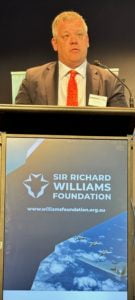
He argued that new C2 concepts require new systems and new doctrinal thinking. But I would argue that is clearly underway and has been achieved in some areas.
But another part of his presentation leads nicely to the final presentation I will discuss here. Rhodes provided an interesting discussion of the Ukrainian experience in ISR and C2 and then considered its relevance to the Pacific theater of operations.
But on his way to his conclusion on this subject he highlighted the question of how a space-based system, namely, Starlink has played a key role in typing together Ukrainian military efforts.
He noted that:
Starlink facts
- Over 4,500 satellites in orbit, more than 50% of all active satellites
- Eventual plans for 42,000 satellites
- Laser crosslink service is rolling out
Ukraine employment
- C2 of aerial and maritime unmanned system
- Tactical communications
- Coordination of artillery fires
Moving information around the battlefield
He then underscored the advantages of LEO constellation over GEOs has been clearly demonstrated in a number of ways in the conflict:
- Lower latency
- Better anti-jam capability
- Less vulnerable to kinetic attack: it is a distributed system that degrades gracefully.
Nick Miller, Optus Satellite and Space division, dealt with the space aspect of ISR and C2 and certainly reinforced both Campbell’s and Rhodes’s presentations. Here Miller talked about how Optus was shaping a way ahead to work with LEO operators to provide both the increased ISR layering Campbell talked about and the C2 for distributed operations that Rhodes talked about.
The focus of his presentation was on “how LEO operations benefit government and defense organizations, and how we plan to integrate LEO and GEO capabilities into our own network for the future.”
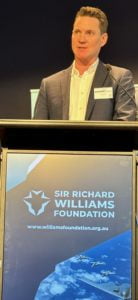
LEO constellations or networks have significant advantages for the creation of the layered ISR and C2 capabilities mentioned earlier by Campbell. As Miller noted: “Due to their proximity to Earth data transmission, time for latency are significantly reduced, allowing enhanced real time communication and decision- making.”
The basic approach taken by Optus is to interweave their GEO satellites with other providers LEO constellations. Miller argued: “The advantage we have as Australia’s longest standing satellite operator is our agnostic ability to actually access and assess each of these technologies and its capabilities to determine the best fit for purpose for enterprise fit for government, and in some cases fit for defense. We see the advantages and disadvantages of each and how they best fold into a GEO network to provide interoperable coverage.”
He added: “The integration of these networks can also offer redundancy and resilience in the face of disruptions or fast changing environments. For instance, if you have a satellite network that becomes compromised, or faces issues such as jamming, the other satellite network can pick up the data to minimize downtime.
“This type of redundancy allows for better support in longer term capability planning, or fast paced decision making when it’s required. When LEO and GEO satellite networks are integrated, critical data can also be efficiently routed between the two systems based on the specific requirements of the mission. High Priority data can take advantage of the low latency LEO connections while less sensitive time sensitive data can be relayed via GEO satellites.”
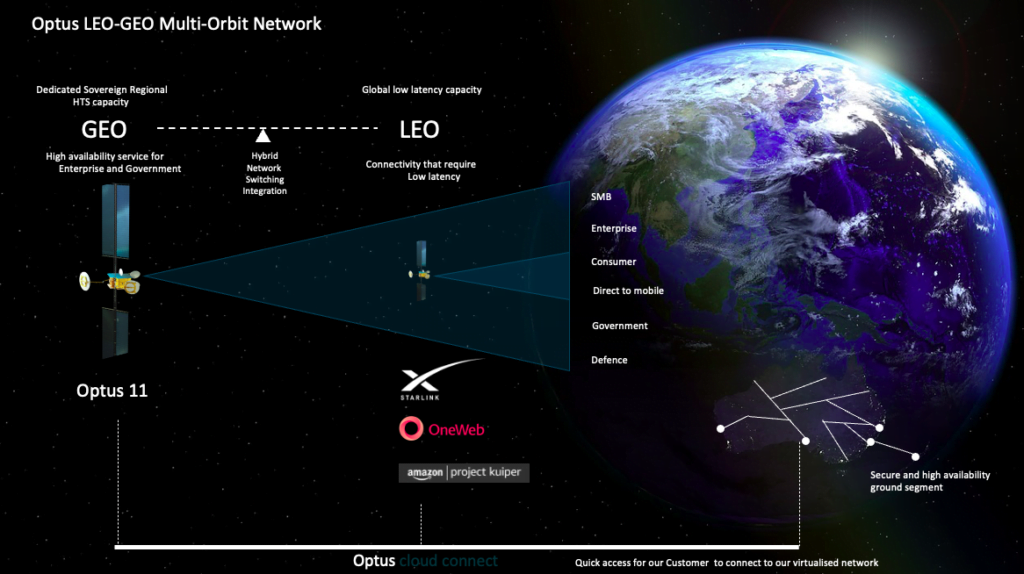
In short, the dynamics of ISR and C2 are shaping the foundation for the multi-domain strike enterprise. They are part of a kill web not just to be fitted into a legacy kill chain approach.
The featured photo is a slide from Jovanovich’s presentation at the 27 September 2023 Williams Foundation Seminar.


